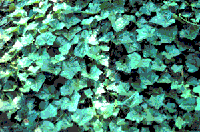Resource Library
Plant of the Week: Ivy, English
The University of Arkansas System Division of Agriculture does not promote, support or recommend plants featured in "Plant of the Week." Please consult your local Extension office for plants suitable for your region.
Plant of the Week
English Ivy
Latin: Hedera helix

Gardeners, like voters, are influenced by their temperament and passion. I consider
myself a solid centrist in this area. I try to recognize the intrinsic value of all
garden plants and not get too consumed by the flaws that all plants possess. But those
to my right in the political array consider me a hopelessly ill-informed bleeding
heart that does not recognize the menace that lurks around the next bend in the garden
path.
English Ivy is often considered one of these menacing plants.
This climbing, evergreen ivy is a member of the aralia family and was introduced
during the colonial era into the US. English Ivy is a rampant vine that will creep
across the ground until it finds something to climb, and then it’s off like a rocket
up the tree trunk or wall.
Ivy takes on two distinct leaf types -- the familiar three or five-lobed leaf of
the fast growing vine and the less familiar unlobed leaf with a long petiole. This
difference in leaf shape is due to the physiological age of the plant, not its chronological
age. As long as ivy is kept on the ground or kept on an upward quest, it will remain
in the juvenile stage and its leaves will maintain their familiar lobed appearance.
If the plant is kept confined to a groundcover bed this condition will be maintained
indefinitely.
Once a plant has climbed something and reached the point where it can grow no further,
it will make the magical transformation to adulthood. Of course with adulthood comes
sex and before you know it there are babies to feed. The white flowers are round pin-cushion
like balls that appear in clusters at the end of the branches that emerge once the
ivy attains adulthood. When ripe the seeds are black, and though somewhat dry, still
relished by birds.
Ivy climbs, not by twining, but by modified stem roots that form a suction-cup structure
known as a "hold fast." These suction cups adhere to about anything from tree bark
to bricks and remain in place when the ivy is ripped down. If ivy is allowed to climb
on a brick wall and later removed, nothing short of sandblasting will remove these
well-cemented hold fasts.
The lament is often heard that ivy is "killing my tree." While this makes intuitive
sense, English Ivy is in no way parasitic and does not kill trees -- at least not
healthy trees. Ivy that is allowed to climb trees will develop a thick trunk, often
the size of a man’s arm, and quickly invade the canopy of the tree. But, as ivy is
a shade plant, it usually lurks in the shadow of the canopy a few feet shy of exposure
to full sun. All of this ivy mass in the top of the tree can cause weakened trees
to topple over in a wind, or struggling trees may produce so little new growth that
the ivy shades out the remaining part of the canopy.
The fear of ivy destroying buildings also needs mention. Ivy hold fasts can create
a maintenance headache if allowed to form on a wall, but they will not grow into and
destroy sound mortar and brick. Wood, though is a different matter and ivy can keep
the moisture level high and encourage wood rot. It also can grow under wooden siding
and cause problems. One of my previous houses had an ivy bed outside by the chimney
where it was allowed to climb. One spring a shoot found its way through the wall and
I had a nice houseplant that I didn’t have to water. Being the lazy soul that I am,
I assumed that the vine was plugging a hole in the wall, thus keeping out cold drafts.
My wife soon pointed out the error in my thinking before the vine expanded enough
to any real damage.
English Ivy can be used as a very effective groundcover in even the shadiest gardens,
but in my opinion, it should not be allowed to climb. By keeping it from climbing
we are in effect neutering it, just as we do with our pets so that we do not have
to deal with unwanted offspring. But even if you choose to let it run free as nature
intended, be assured it will not greet you at the door one fine morning and strangle
you as you walk to the drive to get the paper.
By: Gerald Klingaman, retired
Extension Horticulturist - Ornamentals
Extension News - December 1, 2000
The University of Arkansas System Division of Agriculture does not maintain lists of retail outlets where these plants can be purchased. Please check your local nursery or other retail outlets to ask about the availability of these plants for your growing area.